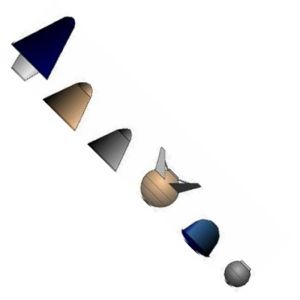
Home - Search - Browse - Alphabetic Index: 0- 1- 2- 3- 4- 5- 6- 7- 8- 9
A- B- C- D- E- F- G- H- I- J- K- L- M- N- O- P- Q- R- S- T- U- V- W- X- Y- Z
McDonnell Project 7969
 Project 7969 Designs Project 7969 ballistic designs. From left: Lockheed; Martin; Aeronutronics; Goodyear; McDonnell; Convair Credit: © Mark Wade |
Status: Study 1958. Gross mass: 1,090 kg (2,400 lb). Height: 2.13 m (6.98 ft).
The capsule weighed 1,090 kg and would be launched by an Atlas with a Polaris second stage.
McDonnell, using its own funds, began work on design of a minimum manned satellite vehicle in March 1956, in response to an Air Research and Development Command briefing on the planned USAF Manned Ballistic Rocket Research program. Company owner Jim McDonnell saw a chance for his small company to gain a foothold in the new arena of spaceflight while the major contractors were asleep at the wheel. He was determined to get the contract and instructed his Advanced Planning Group, led by Raymond Pepping, Lawrence Weeks, John Yardley, and Albert Utsch, to begin developing a minimum manned orbiting spacecraft. The group traded ideas with Max Faget and other NACA engineers at Langley Field who were pushing the same thing from their end.
After the Soviet launch of a dog into orbit in October 1957, McDonnell increased the staff working on the program to 20. This was doubled again by January, when the Air Force, in response to the political firestorm over the Russian lead in space, held its first vendor conference on a manned spacecraft. In April the staff was boosted to 70, and it stayed at that level through June, when McDonnell's 427-page proposal for the Man-In-Space-Soonest program was completed.
The team, influenced by Faget, quickly settled on a pure ballistic shape, akin to that used on the much later Soyuz spacecraft. The satellite would be placed into a 160 km orbit for a 90 minute, single-orbit mission. Tracking would use the Minitrack System and deorbit would be accomplished by retrorocket. Spacecraft attitude control was by rocket thrusters. The spacecraft was under automatic or ground control with the pilot only serving as a test subject. In case of booster failure during ascent to orbit the capsule would be pulled away from the booster by the Polaris second stage and then recovered by parachute.
The spacecraft had a ballistic coefficient (m/CdA) of 300 kg per square meter. Maximum deceleration during re-entry was 8.5 g's. A beryllium heat sink shield, slightly greater in diameter than the base of the capsule, would protect the occupant during the return to earth. Landing precision was within a 650 x 650 km footprint. It was expected that a first manned orbital flight could be achieved 24 months after a go-ahead.
The Air Force program was canceled, but McDonnell's preparation and close work with Faget paid off. In January 1959 they were awarded the contract for NASA's Mercury manned spacecraft. This was followed by the Gemini and Manned Orbiting Laboratory contracts in the 1960's. However their corporate commitment and preparation was noted by Harrison Storms at North American. He made the same kind of commitment four years later, and won the biggest plum, the Apollo contract.
Family: Manned spacecraft. People: McDonnell. Country: USA. Launch Vehicles: Atlas, Atlas D. Agency: USAF. Bibliography: 26, 4472, 483, 59.
Back to top of page
Home - Search - Browse - Alphabetic Index: 0- 1- 2- 3- 4- 5- 6- 7- 8- 9
A- B- C- D- E- F- G- H- I- J- K- L- M- N- O- P- Q- R- S- T- U- V- W- X- Y- Z
© 1997-2019 Mark Wade - Contact
© / Conditions for Use